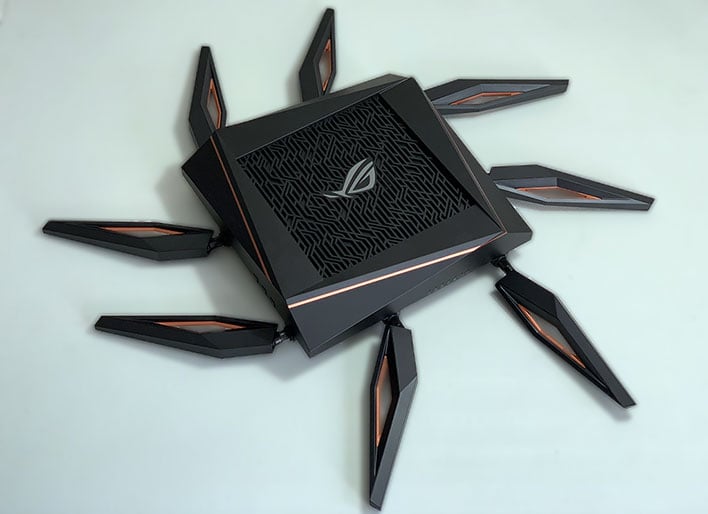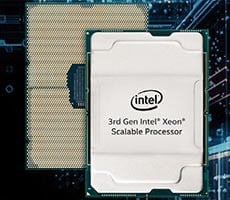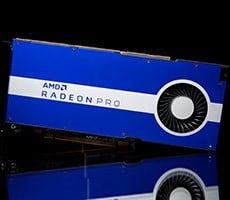We are no longer on the cusp of
Wi-Fi 6 (otherwise known as 802.11ax) connectivity -- it has arrived -- just not in earnest yet. It will take some time before the Wi-Fi 5 (802.11ac) standard is truly shoved aside in favor of the new kid on the block, the one that is faster and more adept at juggling multiple wireless devices simultaneously. Nevertheless, early adopters who want to live on the bleeding edge have options. One of them is the beastly
ASUS ROG Rapture GT-AX11000 we will be showing you here.
As you might have surmised from the
ROG branding, the GT-AX11000 is geared towards power users and gamers. That is also evident by the physical design, which we will discuss in a bit. In terms of connectivity, though, the GT-AX11000 serves up three wireless bands, including a single 2.4GHz band with throughput of up to 1,148Mbps, and two 5GHz bands, each with a theoretical top end of 4,804Mbps. If you add those three bands together, you arrive at a combined throughput of 10,756Mbps, hence the AX11000 (rounded up) designation.
Of course, you can't actually combine all three bands into a single, supercharged connection. However, every router maker has adopted this approach, so it's rather easy to compare two (or more) different models at a glance. That said, knowing how many bands a particular model is working with is important, as it is technically possible for a tri-band model with a higher combined speed rating to actually be slower than a dual-band model with a lower combined speed rating, on a per band basis.
You can put that concern to rest here. Simply put, the GT-AX11000 is the all-around fastest router we have tested to date. Granted, it is only one of two Wi-Fi 6 models that we have had an opportunity to evaluate at this early stage, but for the time being, the GT-AX11000 is the router to beat. It is also one of the more fully featured models available.
We will get to the performance numbers in short order, but first, let's have a look at the GT-AX1000's pertinent specs...
 |
|
ASUS ROG Rapture GT-AX11000 Wi-Fi 6 (802.11ax) Router |
| Specifications & Features
|
|
Wi-Fi Technology
|
Wi-Fi 6 (802.11ax)
OFDMA (Orthogonal Frequency Division Multiple Access)
Beamforming: standard-based and universal
1024-QAM high data rate
20/40/80/160MHz bandwidth
|
| Wi-Fi Performance |
AX11000
|
Data Rate
|
802.11ax (2.4GHz): up to 1,148Mbps, 802.11ax (5GHz): up to 4,804Mbps each
|
Transmit/Receive
|
2.4GHz - 4 x 4, 5GHz - 4 x 4, 5GHz-2 - 4 x 4
|
Processor
|
1.8GHz quad-core processor |
| Memory |
256MB Flash
1GB RAM
|
| Ethernet + USB Ports |
Four (4) 10/100/1000Mbps LAN, One (1) 2.5G LAN, One (1) 10/100/1000Mbps WAN, Two (2) USB 3.1 Gen 1 (5Gbps)
|
| Security |
64-bit WEP, 128-bit WEP, WPA2-PSK, WPA-PSK, WPA-Enterprise, WPA2-Enterprise, WPS support
|
Physical Specs
|
9.5 x 9.5 x 2.4 inches (without bezel)
|
| Package Contents |
One (1) ROG Rapture GT-AX11000 Tri-Band Wi-Fi 6 Router, Eight (8) wireless antennas, One (1) Ethernet cable, Quick start guide, Power adapter
|
| Price |
$449.99 MSRP ($369 current price @ Amazon)
|

At the heart of the GT-AX11000 is a
Broadcom BCM49408 SoC built for high-end routers. It consists of a quad-core 64-bit
ARM processor clocked at 1.8GHz, and in this case is paired with 1GB of RAM and 256MB of flash memory. Routers are robust pieces of tech these days, hence the relatively beefy hardware.
Wi-Fi 6 Recap
We have already gone over the benefits of Wi-Fi 6 versus previous standards in our review of
Netgear's Nighthawk AX8 router, and you should check that out if you need to get up to speed (pun intended). Rather than rehash what we already wrote, the Cliff Notes version is that Wi-Fi 6 is a newfangled protocol that is better equipped for today's increasingly connected households. Long gone are the days when a typical home might only have just two or three PCs needing Internet access—in today's landscapes, an assortment of electronics tap into the cloud, from smartphones and tablets, to Internet-connected TVs and smart speakers, and even some refrigerators.
This comes with a major caveat: a Wi-Fi 6 router is only half of the equation, the other half is the host device. Wi-Fi 6 adapters are few and far between right now, and even if you wanted to, you wouldn't be able to upgrade the Wi-Fi on devices like your TV and game console to Wi-Fi 6, at least not without some serious modding. So for the most part, the biggest advantage of Wi-Fi 6 is what it can deliver down the line, rather than right this very moment.
Wi-Fi devices are starting to trickle in, though. Samsung's
Galaxy S10 phones sport Wi-Fi 6, and both Killer and
Intel have started pushing out
Wi-Fi adapters for PCs and laptops. And because Wi-Fi 6 is backwards compatible with previous standards, you do not have to worry about disrupting your home network with a new router.










